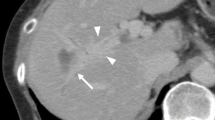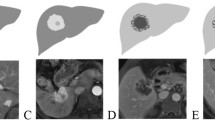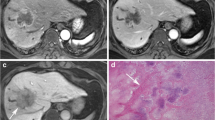Abstract
Background/Purpose
The enhancement pattern in the hepatic arterial phase (HAP) of dynamic computed tomography (CT) is reportedly a prognostic marker in patients with intrahepatic cholangiocarcinoma (IHCC). This study was performed to clarify the significance of central hypo-enhancement in the HAP in patients with mass-forming IHCC.
Methods
Forty patients who had undergone initial surgical resection for mass-forming IHCC were enrolled. The dynamic CT was scanned 40 s after contrast agent injection as the HAP. A radiologist classified the patients into three groups based on the vascular pattern: the hyper-enhancement group (Hyper group), rim-enhancement group (Rim group), and hypo-enhancement group (Hypo group). The surgical specimens were immunohistochemically stained for hypoxia-inducible factor 1 (HIF-1). The correlation with clinicopathological findings and HIF-1 expression was investigated.
Results
The Hyper, Rim, and Hypo groups comprised 8, 7, and 25 patients, respectively. There were no significant correlations between the groups and clinicopathological factors. Overall survival (OS) was significantly worse in the Hypo than in the Hyper group (p = 0.03). OS was also significantly worse in the Rim + Hypo group (i.e., hypo-enhancement in the central tumor) than in the Hyper group (p = 0.04). Furthermore, inclusion in the Rim + Hypo group was a prognostic factor for OS (hazard ratio 6.68). High HIF-1 expression in the central part of the tumor was correlated with central hypo-enhancement (Hyper group: 25% and Rim + Hypo group: 72%).
Conclusions
Central hypo-enhancement was a prognostic factor in patients with IHCC. The high malignant potential of tumors with central hypo-enhancement might be associated with HIF-1 upregulation.




Similar content being viewed by others
Abbreviations
- IHCC:
-
Intrahepatic cholangiocarcinoma
- HAP:
-
Hepatic arterial phase
- CT:
-
Computed tomography
- HIF-1:
-
Hypoxia-inducible factor 1
- IHC:
-
Immunohistochemistry
- ROI:
-
Region of interest
- PI:
-
Periductal infiltrating
References
Bridgewater J, Galle PR, Khan SA et al (2014) Guidelines for the diagnosis and management of intrahepatic cholangiocarcinoma. J Hepatol 60(6):1268–1289
Zhang H, Yang T, Wu M et al (2016) Intrahepatic cholangiocarcinoma: Epidemiology, risk factors, diagnosis and surgical management. Cancer Lett 379(2):198–205
Patel T (2002) Worldwide trends in mortality from biliary tract malignancies. BMC Cancer 3(2):10
Roayaie S, Guarrena JV, Ye MQ et al (1998) Aggressive surgical treatment of intrahepatic cholangiocarcinoma: predictors of outcomes. J Am Coll Surg 187:365–372
Isaji S, Kawarada Y, Taoka H et al (1999) Clinicopathological features and outcome of hepatic resection for intrahepatic cholangiocarcinoma in Japan. J Hepatobiliary Pancreat Surg 6:108–116
Ariizumi S, Kotera Y, Takahashi Y et al (2011) Mass-forming intrahepatic cholangiocarcinoma with marked enhancement on arterial-phase computed tomography reflects favorable surgical outcomes. J Surg Oncol 104(2):130–139
Yamamoto Y, Türkoğlu MA, Aramaki T et al (2016) Vascularity of intrahepatic cholangiocarcinoma on computed tomography is predictive of lymph node metastasis. Ann Surg Oncol 23(Suppl 4):485–493
Kim SA, Lee JM, Lee KB et al (2011) Intrahepatic mass-forming cholangiocarcinomas: enhancement patterns at multiphasic CT, with special emphasis on arterial enhancement pattern–correlation with clinicopathologic findings. Radiology 260(1):148–157
Nanashima A, Abo T, Murakami G et al (2013) Intrahepatic cholangiocarcinoma: relationship between tumor imaging enhancement by measuring attenuation and clinicopathologic characteristics. Abdom Imaging 38(4):785–792
Fujita N, Asayama Y, Nishie A et al (2017) Mass-forming intrahepatic cholangiocarcinoma: enhancement patterns in the arterial phase of dynamic hepatic CT—correlation with clinicopathological findings. Eur Radiol 27(2):498–506
Wang GL, Jiang BH, Rue EA et al (1995) Hypoxia-inducible factor 1 is a basic-helix-loop-helix-PAS heterodimer regulated by cellular O2 tension. Proc Natl Acad Sci USA 92(12):5510–5514
Iyer NV, Kotch LE, Agani F et al (1998) Cellular and developmental control of O2 homeostasis by hypoxia-inducible factor 1 alpha. Genes Dev 12(2):149–162
Lee JW, Bae SH, Jeong JW et al (2004) Hypoxia-inducible factor (HIF-1)alpha: its protein stability and biological functions. Exp Mol Med 36(1):1–12
Liver Cancer Study Group of Japan (2009) General rules for the clinical and pathological study of primary liver cancer. Kanehara & Co., Ltd, Tokyo
Morine Y, Shimada M, Ikegami T et al (2009) Usefulness of gemcitabine combined with 5-fluorouracil and cisplatin (GFP) in patients for unresectable biliary carcinoma. Hepatogastroenterology 56(90):307–312
Teraoku H, Morine Y, Ikemoto T et al (2016) Role of thrombospondin-1 expression in colorectal liver metastasis and its molecular mechanism. J Hepatobiliary Pancreat Sci 23(9):565–573
Zhao X, Gao S, Ren H et al (2014) Hypoxia-inducible factor-1 promotes pancreatic ductal adenocarcinoma invasion and metastasis by activating transcription of the actin-bundling protein fascin. Cancer Res 74(9):2455–2464
Zhong H, De Marzo AM, Laughner E et al (1999) Overexpression of hypoxia-inducible factor 1 alpha in common human cancers and their metastases. Cancer Res 59(22):5830–5835
Koike T, Kimura N, Miyazaki K et al (2004) Hypoxia induces adhesion molecules on cancer cells: a missing link between Warburg effect and induction of selectin-ligand carbohydrates. Proc Natl Acad Sci USA 101(21):8132–8137
Giatromanolaki A, Koukourakis MI, Sivridis E et al (2001) Relation of hypoxia inducible factor 1α and 2α in operable non-small cell lung cancer to angiogenic/molecular profile of tumours and survival. Br J Cancer 85:881–890
Sivridis E, Giatromanolaki A, Gatter KC et al (2002) Association of hypoxia-inducible factors 1αand 2αwith activated angiogenic pathways and prognosis in patients with endometrial carcinoma. Cancer 95:1055–1063
Baba Y, Nosho K, Shima K et al (2010) HIF1A overexpression is associated with poor prognosis in a cohort of 731 colorectal cancers. Am J Pathol 176(5):2292–2301
Lee J, Kim SH, Kang TW et al (2016) Mass-forming intrahepatic cholangiocarcinoma: diffusion-weighted imaging as a preoperative prognostic marker. Radiology 281(1):119–128
Lewis S, Besa C, Wagner M et al (2018) Prediction of the histopathologic findings of intrahepatic cholangiocarcinoma: qualitative and quantitative assessment of diffusion-weighted imaging. Eur Radiol 28(5):2047–2057
Acknowledgement
We thank Angela Morben, DVM, ELS, from Edanz Group (www.edanzediting.com/ac), for editing a draft of this manuscript.
Author information
Authors and Affiliations
Corresponding author
Ethics declarations
Conflict of interest
The authors declare that they have no competing interests.
Informed consent
This study was approved by the Research Ethics Committee of Tokushima University Hospital, and written informed consent was obtained from all patients.
Additional information
Publisher's Note
Springer Nature remains neutral with regard to jurisdictional claims in published maps and institutional affiliations.
Rights and permissions
About this article
Cite this article
Teraoku, H., Morine, Y., Uyama, N. et al. Role of Central Hypo-enhancement in the Hepatic Arterial Phase of Dynamic Computed Tomography in Patients with Mass-Forming Intrahepatic Cholangiocarcinoma. World J Surg 44, 2350–2358 (2020). https://doi.org/10.1007/s00268-020-05456-8
Published:
Issue Date:
DOI: https://doi.org/10.1007/s00268-020-05456-8




